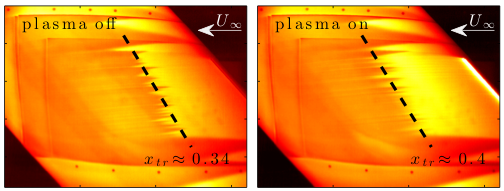GlowWing
Funding
ERC Starting Grant
Duration
February 2019 – February 2024
Research team
Dr.ir. Marios Kotsonis (Coordinator)
Dr. ir. Theo Michelis
Junior researchers
G. Zoppini, MSc. (PhD candidate)
Research summary
Delay of laminar-turbulent flow transition on aircraft wings can potentially reduce aerodynamic drag by up to 15%, reducing emissions and fuel consumption considerably. The main cause of laminar-turbulent transition on commonly used swept wings is the development of crossflow (CF) instabilities. Despite their importance, our fundamental understanding of CF instabilities is limited due to inability of current measurement techniques to capture their complex and multi-scale spatio-temporal features. This severely limits our ability to delay CF transition, which is further impeded by the lack of simple, robust and efficient control concepts. In this ERC Starting Grant project we will achieve unprecedented spatio-temporal measurements of CF instabilities and develop a novel active flow control system that can successfully delay transition on swept wings. To achieve these goals, we bring forth a unique combination of cutting-edge technologies, such as tomographic particle image velocimetry, advanced plasma-based actuators and linear/non-linear stability and control theory. Spatio-temporal volumetric velocity measurements of CF instabilities will be achieved at three important stages of their life, namely inception, growth and breakdown, providing breakthrough insights into the underlying physics of swept wing transition and turbulence production. The results will be used to postulate and validate linear and non-linear stability and control theory models and provide top benchmarks for high-fidelity CFD. The unprecedented wealth of information, enabled through these advances, will be used to design and demonstrate the first synergetic plasma-based laminar flow control system. This system will feature minimum-thickness plasma actuators, able to suppress the growth of CF instabilities and achieve and sustain considerable transition delay at high Reynolds numbers. These advances will finally enable robust and efficient laminar flow on future air transport.

Dr.ir. Marios Kotsonis
For more information about the project or working group please click here.
Funded by





